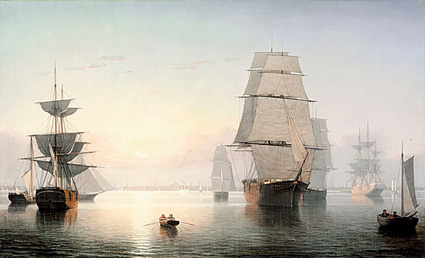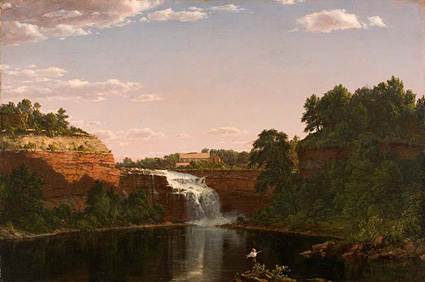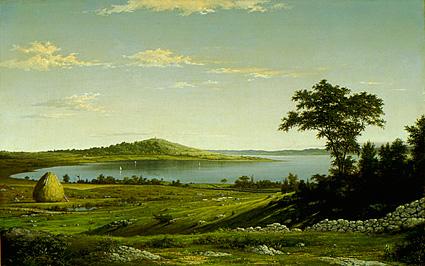I’ve been lucky enough to travel all around the States since I was a kid. But it wasn’t until I did a cross-country road trip at age eighteen, free of parents and continental breakfasts, that I really discovered America for myself. Since then I’ve done three or four more such trips—once to New Orleans and back, once through the Midwest, and twice between New York and L.A. Traveling by land—seeing the land—is a truly different experience than hop-scotching by air. Seeing the colors of the Southwestern desert drain away into the Texan expanse; feeling small amidst the vast flatness of Nebraska and Kansas; being surrounded by the orange and gold trees of Ohio in fall; reaching the Eastern shores and remembering the West Coast’s beaches—none of these landscapes, by themselves, are quintessentially American; you have to take all of it in to get the picture.

Martin Johnson Heade, "Rhode Island Shore," 1858, gift of Charles C. and Elma Ralphs Shoemaker
That feeling came back to me during a recent stroll through the American galleries, moving from Martin Johnson Heade’s Rhode Island Shore and Fitz Henry Lane’s Boston Harbor, Sunset to Albert Bierstadt’s The Grizzly Giant Sequoia, Mariposa Grove, California and Thomas Moran’s Hot Springs of the Yellowstone. The bays and mountains and trees, the dark blues and rough browns and vibrant greens, all added up to a larger portrait of the nation (very unlike that created by the narrative paintings of the recent American Stories exhibition, though in some ways just as arresting). With the land in mind, I even saw Winslow Homer’s Cotton Pickers in a new way—focusing more on the golden sky and the field of cotton more than the two women in the foreground. You could remove them from the painting and still know this is the South.

Fitz Henry Lane, "Boston Harbor, Sunset," 1850–55, gift of Jo Ann and Julian Ganz, Jr., in honor of the museum’s 25th anniversary
Many of these landscapes suggest human presence—boats in Lane’s Boston Harbor, a stone wall in Heade’s Rhode Island Shore—though usually dwarfed by nature. Living in the paved garden that is Los Angeles, these intrusions—even that modest stone wall—pricked at me. None more so than the mill in Frederic Edwin Church’s Lower Falls, Rochester.

Frederic Edwin Church, "Lower Falls, Rochester," 1849, gift of Charles C. and Elma Ralphs Shoemaker
So much of Church’s painting is nature at its most imposing—the vast sky, the red cliffs, the luminous water, the verdant trees, the cascading waterfall. In the bottom of the painting is a young fisherman, miniscule by comparison. Not so miniscule is the mill, situated at the dead center of the painting. Its position seems to anoint human achievement with an unbalanced power. Nature is segmented in relation to the mill—sky above, water below, trees and cliffs to the left and right—as if the structure were the center of its own solar system, the land bound to revolve around its axis.
Walking from these galleries to the more modern—urban—works such as George Bellows’s Cliff Dwellers and Millard Sheets’s Angel’s Flight, Church’s mill hung over me. But so too did the land: I wanted to reject Bellows’s cityscape, to say no. I actually turned around and walked back to the galleries I’d just been in, to soak up the nation’s landscape again.



